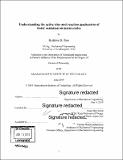Understanding the active sites and reaction mechanism of water oxidation on metal oxides
Author(s)
Rao, Reshma R.
Download1117714036-MIT.pdf (43.12Mb)
Other Contributors
Massachusetts Institute of Technology. Department of Mechanical Engineering.
Advisor
Yang Shao-Horn.
Terms of use
Metadata
Show full item recordAbstract
Solar energy irradiating the Earth's surface exceeds human energy consumption by four orders of magnitude and the key to alleviating the global energy crisis lies in efficiently harnessing it. An ideal means of storing surplus energy from solar is to convert it to hydrogen using proton exchange membrane water electrolyzers, which are amenable to integration with solar devices due to their high performance under fluctuating power input. Water oxidation to molecular oxygen is the most energy intensive part of the water splitting process, limiting the overall efficiency of water splitting devices. Rutile Ruthenium Dioxide (RuO₂) is a gold standard catalyst for water oxidation in acidic solutions. It can also undergo fast surface redox reactions in the electrochemically stable potential window of water, making it an ideal material for electrochemical capacitors that can charge and discharge in a much shorter time scale than batteries. Understanding the interaction of RuO₂ with water can provide critical insights into the physical origin of its fascinating electrochemical properties and the active site(s) for water oxidation. Herein, we use ambient pressure X-ray photoelectron spectroscopy, in situ surface diffraction, surface enhanced infrared spectroscopy, electrochemical mass spectrometry and ab initio density functional theory calculations on well-defined RuO₂ surfaces to understand the mechanism and kinetics of the water oxidation reaction. We elucidate how different surface terminations can alter the binding energetics of oxygenated intermediates by changing the local environment of surface ruthenium and oxygen atoms. Going beyond the conventional approach of changing the surface chemistry to tune the energetics of active sites, we also consider how changing the nature of the electrolyte (pH, cations in the supporting electrolyte) can modify the interfacial dynamics and increase electrocatalytic activity. Finally, we consider the use of Li-rich layered ruthenium oxides as a means to access bulk ruthenium redox for electrocatalytic reactions. Thus, through the use of surface-sensitive in operando techniques, this thesis identifies the active sites and reaction mechanism for oxygen electrocatalysis and demonstrates how catalyst surface structure and interfacial water structure can be altered to improve kinetics for next-generation water oxidation catalysts.
Description
Thesis: Ph. D., Massachusetts Institute of Technology, Department of Mechanical Engineering, 2019 Cataloged from PDF version of thesis. Includes bibliographical references (pages 184-196).
Date issued
2019Department
Massachusetts Institute of Technology. Department of Mechanical EngineeringPublisher
Massachusetts Institute of Technology
Keywords
Mechanical Engineering.